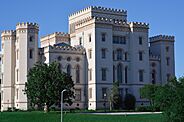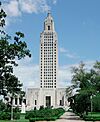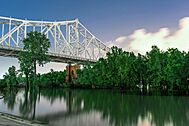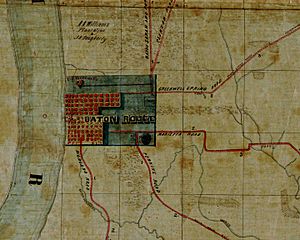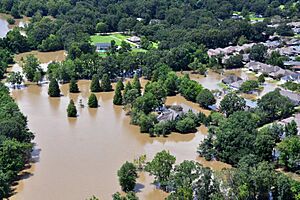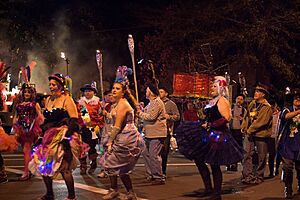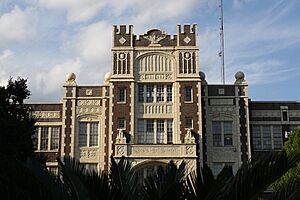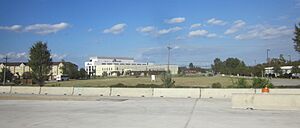Baton Rouge, Louisiana facts for kids
Quick facts for kids
Baton Rouge
Bâton-Rouge (French)
Batonrouj (Louisiana Creole) |
|||||
|---|---|---|---|---|---|
|
State capital city and
consolidated city-parish |
|||||
|
Downtown Baton Rouge
St. Joseph Cathedral
Huey P. Long Bridge
Tiger Stadium (LSU)
|
|||||
|
|||||
| Etymology: from French bâton rouge, meaning 'red stick' | |||||
| Nicknames:
Red Stick, The Capital City, B.R.
|
|||||
| Country | United States | ||||
| State | Louisiana | ||||
| Parish | East Baton Rouge | ||||
| Founded | 1699 | ||||
| Settled | 1721 | ||||
| Incorporated | January 16, 1817 | ||||
| Area | |||||
| • State capital city and consolidated city-parish |
88.52 sq mi (229.27 km2) | ||||
| • Land | 86.32 sq mi (223.56 km2) | ||||
| • Water | 2.20 sq mi (5.71 km2) | ||||
| • Total | 79.11 sq mi (204.89 km2) | ||||
| Elevation | 46 ft (14 m) | ||||
| Population
(2020)
|
|||||
| • State capital city and consolidated city-parish |
227,470 | ||||
| • Rank | US: 99th | ||||
| • Density | 2,635.32/sq mi (1,017.50/km2) | ||||
| • Urban | 631,326 (US: 67th) | ||||
| • Urban density | 1,592.9/sq mi (615.0/km2) | ||||
| • Metro | 870,569 (US: 66th) | ||||
| Demonym(s) | Baton Rougean | ||||
| Time zone | UTC−6 (CST) | ||||
| • Summer (DST) | UTC−5 (CDT) | ||||
| ZIP Codes |
70801–70817, 70819–70823, 70825–70827, 70831, 70833, 70835–70837, 70874, 70879, 70883, 70884, 70892–70896, 70898
|
||||
| Area code(s) | 225 | ||||
| FIPS code | 22-05000 | ||||
| GNIS feature ID | 1629914 | ||||
Baton Rouge is the capital city of Louisiana, a state in the United States. In 2020, about 227,470 people lived there, making it Louisiana's second-largest city. It is also the main city of East Baton Rouge Parish, which is the most populated parish in Louisiana. The larger area around Baton Rouge, called Greater Baton Rouge, had about 870,569 residents in 2020.
Baton Rouge is located on the eastern side of the Mississippi River. Its location on the Istrouma Bluff, a natural high point, was very important. This bluff kept the city safe from floods that often happen along the Mississippi River. This allowed businesses to grow without worrying about seasonal flooding.
The city has a rich mix of cultures. People from Europe settled here, and African people were brought to North America. Baton Rouge has been ruled by seven different nations over time. These include the French, Spanish, and British during colonial times. It was also briefly part of the Republic of West Florida, then the United States, and the Confederate States of America during the Civil War. After the war, it became part of the United States again.
Today, Baton Rouge is a major center for industry, medicine, research, movies, and technology in the Southern United States. It is home to Louisiana State University (LSU), which is the state's biggest university. It also has Southern University, a famous historically black college system.
The Port of Greater Baton Rouge is one of the largest ports in the U.S. It can handle very big ships, called Panamax ships, far up the Mississippi River. Many big companies like Amazon, ExxonMobil, and Dow Chemical Company have a presence in the Baton Rouge area.
Contents
- Exploring Baton Rouge's Past
- Where is Baton Rouge?
- Who Lives in Baton Rouge?
- Baton Rouge's Economy
- Culture and Arts in Baton Rouge
- Fun Things to Do in Baton Rouge
- Sports in Baton Rouge
- Parks and Outdoor Fun
- Learning in Baton Rouge
- Media in Baton Rouge
- Getting Around Baton Rouge
- Sister Cities
- Images for kids
- See also
Exploring Baton Rouge's Past
How Baton Rouge Got Its Name

The name "Baton Rouge" means "the red stick" in French. In 1698, French explorer Pierre Le Moyne d'Iberville traveled up the Mississippi River. He saw a red pole that marked the border between the hunting lands of two Native American tribes, the Houma and Bayagoula. The native word for this pole was "Istrouma," which might come from the Choctaw word iti humma meaning "red pole."
European settlers first came to Baton Rouge in 1721. They built a military and trading post. Over the years, Baton Rouge was governed by France, Britain, and Spain. Many French settlers, known as Acadians, moved to Louisiana, including Baton Rouge, after being forced out of Canada by the British in 1755. These settlers became known as Cajuns.
Becoming a City and Growing Up
Baton Rouge officially became a town in 1817. In 1846, the state government decided to move Louisiana's capital from New Orleans to Baton Rouge. The architect James Dakin designed the old Louisiana State Capitol. It looks like a castle with turrets and stained glass, overlooking the Mississippi River. It's a famous example of Gothic Revival architecture.
By the time the American Civil War started, Baton Rouge had about 5,500 people. The war slowed down the city's growth. After the war, the state government moved back to Baton Rouge in 1882.
In the 1950s and 1960s, the oil and chemical industries grew a lot in Baton Rouge. This helped the city expand. In 2005, after Hurricane Katrina caused a lot of damage in New Orleans, Baton Rouge welcomed many people who had to leave their homes. The city has continued to grow and develop, especially in technology.
Where is Baton Rouge?
Baton Rouge is located in southeastern Louisiana, right on the Mississippi River. It's about 79 miles (127 km) from New Orleans. The city sits on a low elevation, about 46 feet (14 meters) above sea level.
Baton Rouge is special because it's on the first set of natural bluffs (cliffs) north of the Mississippi River Delta. This high ground protects the city from floods. It is also one of the southernmost capital cities in the continental United States.
What is Baton Rouge's Climate Like?
Baton Rouge has a humid subtropical climate. This means it has mild winters and hot, humid summers. It gets a lot of rain throughout the year. Snow is very rare.
Because it's close to the Gulf of Mexico, Baton Rouge can be affected by hurricanes. In 2008, Hurricane Gustav hit the city, causing strong winds and power outages. The city also experienced severe flooding in August 2016.
Who Lives in Baton Rouge?
Baton Rouge has a diverse population. Before Europeans arrived, Native Americans lived here. Over time, people from Europe and Africa came to the area.
In 2020, the largest group in Baton Rouge was Black or African Americans, making up about 53.55% of the city's population. Non-Hispanic white people made up about 34.22%. There are also growing numbers of Asian people and Hispanic or Latino people. Many residents also identify as Cajuns or Louisiana Creole.
What Religions are Practiced in Baton Rouge?
Christianity is the most common religion in Baton Rouge. This includes many different types, like Catholicism and Protestantism. The city has many Catholic churches and is home to the Roman Catholic Diocese of Baton Rouge. There are also many Baptist and Methodist churches.
Other religions are also present in Baton Rouge. Islam is the second-largest religion, with several mosques in the area. There are also small communities of Jewish people, Buddhists, and Hindus.
Baton Rouge's Economy

Baton Rouge has a strong economy. It has been ranked as one of the best places for young adults and for starting new businesses. Many companies have their headquarters or offices here, such as Lamar Advertising Company, BBQGuys, Marucci Sports, and Raising Cane's Chicken Fingers. Amazon and Microsoft also have a presence in the area.
The biggest industry in Baton Rouge is making petrochemicals. The ExxonMobil oil refinery in Baton Rouge is one of the largest in the country. The city's location on the Mississippi River allows for easy shipping of goods by boat, rail, and pipeline.
The state government is also a major employer in Baton Rouge, as it is the state capital. Louisiana State University also employs many people. The city is growing as a center for medical research and healthcare, with several hospitals and research centers.
Baton Rouge has also become a popular place for the film industry in Louisiana. Many movies and TV shows are filmed here, thanks to special tax benefits from the state. The Celtic Media Centre is a large film production facility in the city.
Culture and Arts in Baton Rouge
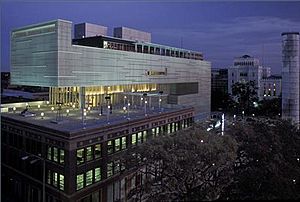
Baton Rouge has a unique culture, blending Cajun and Creole traditions with African American influences. It's also a "college town" with several universities, including Louisiana State University and Southern University. The many students and international residents add to the city's diverse culture.
Arts and Theater Scene
Baton Rouge has a lively arts scene, especially downtown. You can find professional theater groups like Theatre Baton Rouge, the Baton Rouge Symphony Orchestra, and the Baton Rouge Ballet Theatre.
The Shaw Center for the Arts is a major art center. It has art galleries, the LSU Museum of Art, a theater, and restaurants. The Louisiana Art and Science Museum is another popular spot, with art exhibits, space displays, and a planetarium.
The city also has special "arts and cultural districts" that help promote cultural activities. For example, the Mid-City Cultural District and the Perkins Road Arts District.
Miss USA Pageants in Baton Rouge
Baton Rouge has hosted the Miss USA pageant twice, in 2014 and 2015. This big event brought contestants from all over the country to the city.
Fun Things to Do in Baton Rouge

Baton Rouge has many interesting places to visit. You can see beautiful old buildings like the neo-Gothic Old Louisiana State Capitol and the much taller, modern Louisiana State Capitol. There are also historic plantation homes nearby, such as Magnolia Mound Plantation House.
The Louisiana State University campus is known for its beautiful Italian Renaissance-style buildings and many old oak trees. It also has one of the largest college stadiums in the country.
Museums and Attractions
- The Capitol Park Museum and the Old Louisiana State Capitol Museum teach you about Louisiana's history.
- The Shaw Center for the Arts and the Louisiana Art and Science Museum offer art and science exhibits. The LASM also has a cool planetarium.
- The USS Kidd is a historic Navy ship you can explore.
- The Odell S. Williams Now And Then African-American Museum tells the story of African Americans in the area.
Every fall, you can enjoy the Greater Baton Rouge State Fair, which has rides, games, and fun for everyone. For shopping and dining, check out the Mall of Louisiana and Perkins Rowe. You can also visit amusement parks like Dixie Landin' and Blue Bayou.
Sports in Baton Rouge
College sports are a big part of life in Baton Rouge. The LSU Tigers and the Southern University Jaguars are both NCAA Division I teams. Football is very popular, with the LSU Tigers football and Southern Jaguars football teams drawing big crowds. Basketball, baseball, and gymnastics are also well-loved.
Baton Rouge is also home to some unique sports teams. The Baton Rouge Tigers play Australian rules football. The Baton Rouge Rugby Football Club has been playing since 1977. There's also a roller derby league called Red Stick Roller Derby.
The city recently got a new professional hockey team, the Baton Rouge Zydeco, who play at the River Center.
Parks and Outdoor Fun
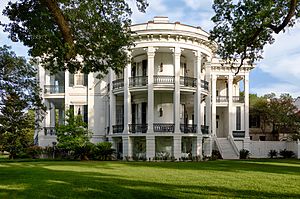
Baton Rouge has many parks managed by the Recreation and Park Commission (BREC). City Park is one of the largest. The Baton Rouge Zoo is also run by BREC and has over 1,800 different animals.
There are also several national protected areas and historic places, like the Atchafalaya National Heritage Area and the Independence Park Botanic Gardens.
Learning in Baton Rouge
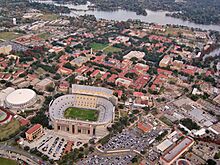
Baton Rouge is a great place for education, with many universities and colleges.
- Louisiana State University (LSU) is the biggest university in Louisiana, with over 30,000 students.
- Southern University and A&M College is a historic black college and university (HBCU) and the second-oldest public university in Louisiana.
- Franciscan Missionaries of Our Lady University offers programs in nursing and health sciences.
- Baton Rouge Community College is a two-year college with over 8,000 students.
- The Pennington Biomedical Research Center does important research on health.
Schools for Kids
The East Baton Rouge Parish Public Schools system runs the elementary, middle, and high schools in the city. It's the second-largest public school system in Louisiana. There are also many charter schools in Baton Rouge, offering different learning styles.
Libraries for Everyone
Baton Rouge has excellent libraries. The State Library of Louisiana offers millions of items and resources to residents. The East Baton Rouge Parish Library System has a main library and 13 community libraries, providing books, computers, and help with research. The Louisiana State Archives also has a research library with historical records.
Media in Baton Rouge
The main daily newspaper for Baton Rouge is The Advocate. There are also many other local magazines and newspapers.
Baton Rouge has several local TV stations, including channels for ABC, CBS, NBC, Fox, and PBS.
Getting Around Baton Rouge
Highways and Roads
Baton Rouge has three major interstate highways: I-10, I-12, and I-110.
- I-10 crosses the Mississippi River on the Horace Wilkinson Bridge and goes towards New Orleans.
- I-12 starts in Baton Rouge and heads east.
- I-110 goes north and south through downtown and past the airport.
Other important roads include Airline Highway (US 61) and Florida Boulevard.
Buses and Public Transport
The Capital Area Transit System (CATS) provides bus service throughout Baton Rouge. This includes routes to the universities. Greyhound Bus Lines also has a station downtown for travel across the United States.
Shipping and Airport
The Port of Greater Baton Rouge is a very busy port on the Mississippi River. The Baton Rouge Metropolitan Airport connects the city to major airline hubs in the southern U.S., with flights to cities like Atlanta and Houston.
Trains
Three major railroads provide freight service to Baton Rouge. There are also plans to bring back passenger train service between Baton Rouge and New Orleans.
Sister Cities
Baton Rouge has "sister city" relationships with several cities around the world. These connections help promote cultural exchange and understanding.
 Cairo, Cairo Governorate, Egypt
Cairo, Cairo Governorate, Egypt Rouen, Seine-Maritime, France
Rouen, Seine-Maritime, France Taichung, Taiwan
Taichung, Taiwan Ciudad Obregón, Sonora, Mexico
Ciudad Obregón, Sonora, Mexico Port-au-Prince, Ouest, Haiti
Port-au-Prince, Ouest, Haiti Liège, Liège Province, Belgium
Liège, Liège Province, Belgium Aix-en-Provence, Bouches-du-Rhône, France
Aix-en-Provence, Bouches-du-Rhône, France Córdoba, Veracruz, Mexico
Córdoba, Veracruz, Mexico Heze, Shandong, China
Heze, Shandong, China Malatya, Malatya Province, Turkey
Malatya, Malatya Province, Turkey Guiyang, Guizhou, China
Guiyang, Guizhou, China
Images for kids
See also
 In Spanish: Baton Rouge para niños
In Spanish: Baton Rouge para niños



